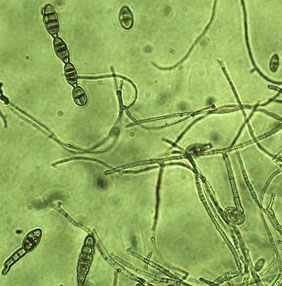„Masked“ mycotoxins
Hidden fungal toxins
Mycotoxins are toxins formed by filamentous fungi. Many of them have a high toxic potential and can cause cancer, among other diseases. For this reason, the EU has set limits for many mycotoxins in foodstuffs and compliance is monitored by the official food control authorities.
However, research in recent years has shown that plants or fruit and vegetables infested with fungi are capable of metabolizing mycotoxins. These modified fungal toxins are usually not detected by standard laboratory analytical methods, thus underestimating the overall contamination of food with mycotoxins. For this reason, these metabolites are also called "masked" mycotoxins or “emerging” mycotoxins. In addition, insufficient data often exist on the toxic effects of these metabolites.
In the context of consumer protection, the Department of Safety and Quality of Fruit and Vegetables is involved in research of "masked" mycotoxins. In this process, fruit and vegetable species are first infected with various mycotoxin-forming fungi in order to subsequently identify and structurally analyze unknown "masked" mycotoxins in these samples. State-of-the-art analytical methods are used, such as high-performance liquid chromatography coupled with high-resolution mass spectrometry (UHPLC-HRMS) as well as, in cooperation with the Karlsruhe Institute of Technology (KIT, AK Prof. Bunzel), NMR analyses.
A current project deals, among other things, with Alternaria toxins and the interaction with various plant foods. Alternaria toxins are formed by fungi of the genus Alternaria (sooty mold). Alternaria alternata is a very common species and infects cereals and various fruits and vegetables, such as tomatoes and apples.
The Alternaria toxins alternariol (AOH) and alternariol-9-methylether (AME) show a genotoxic potential in in vitro experiments and are therefore in the focus of the European Food Safety Authority (EFSA). Plant enzymes could form so-called conjugates by linking free hydroxyl groups of AOH and AME with different chemical groups (e. g. glucose).
In this context, the Department of Safety and Quality of Fruit and Vegetables showed, using tomato as an example, that conjugates of AOH and AME are indeed formed. Since it is possible that AOH and AME are released again in the gastrointestinal tract of humans by cleavage of these conjugates, the discovery of these previously unknown "masked" mycotoxins is highly relevant. The results have been published in an international journal. https://www.openagrar.de/receive/openagrar_mods_00022664
Building on these results, the Department of Safety and Quality of Fruit and Vegetables is continuing research in the field of “masked” mycotoxins in order to gain new insights and thereby contribute to consumer protection and food safety.
Scientific publication(s)
Original publication:
Soukup ST, Kohn BN, Pfeiffer E, Geisen R, Metzler M, Bunzel M, Kulling SE (2016) Sulfoglucosides as novel modified forms of the mycotoxins alternariol and alternariol monomethyl ether. Journal of Agricultural and Food Chemistry, 64, 8892-8901. doi: 10.1021/acs.jafc.6b03120.


